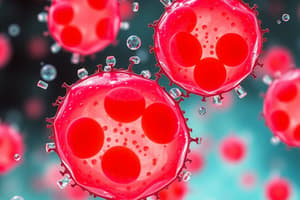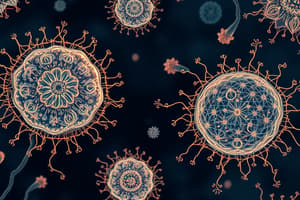Podcast
Questions and Answers
What is the primary function of telomeres in chromosomes?
What is the primary function of telomeres in chromosomes?
- They facilitate gene expression.
- They aid in DNA replication.
- They prevent ends of chromosomes from attaching to each other. (correct)
- They help pack DNA into nucleosomes.
What role do H1 histones play in DNA packaging?
What role do H1 histones play in DNA packaging?
- They bind to RNA for gene expression.
- They form the core of the nucleosome.
- They initiate DNA replication.
- They help compact adjacent nucleosomes further. (correct)
How are radial loop domains formed?
How are radial loop domains formed?
- By attaching ribosomes to the RNA.
- Through the binding of DNA with the nuclear matrix. (correct)
- By the unwinding of linear DNA.
- By forming multiple nucleosomes without H1 histones.
What is the diameter of the more compact structure formed after nucleosomes associate?
What is the diameter of the more compact structure formed after nucleosomes associate?
What component in histone proteins interacts with DNA phosphate?
What component in histone proteins interacts with DNA phosphate?
What is the primary function of lysosomes in a cell?
What is the primary function of lysosomes in a cell?
What do peroxisomes primarily contribute to cellular metabolism?
What do peroxisomes primarily contribute to cellular metabolism?
Which of the following accurately describes Griffith's experiment?
Which of the following accurately describes Griffith's experiment?
What was the conclusion of the Avery-MacLeod-McCarty experiment regarding the transformation principle?
What was the conclusion of the Avery-MacLeod-McCarty experiment regarding the transformation principle?
Which organelles are primarily responsible for producing ATP?
Which organelles are primarily responsible for producing ATP?
What is not a principle of cell theory?
What is not a principle of cell theory?
What characteristic distinguishes smooth pneumococcus bacteria from rough pneumococcus bacteria?
What characteristic distinguishes smooth pneumococcus bacteria from rough pneumococcus bacteria?
What is the process involved in the conversion of ATP to ADP?
What is the process involved in the conversion of ATP to ADP?
Which structure is found in eukaryotic cells but not in prokaryotic cells?
Which structure is found in eukaryotic cells but not in prokaryotic cells?
What is the primary characteristic that distinguishes Gram-positive bacteria from Gram-negative bacteria?
What is the primary characteristic that distinguishes Gram-positive bacteria from Gram-negative bacteria?
What is the significance of major and minor grooves in nucleic acid structure?
What is the significance of major and minor grooves in nucleic acid structure?
Which type of flagella arrangement refers to a single flagella at one pole of the cell?
Which type of flagella arrangement refers to a single flagella at one pole of the cell?
What role do teichoic acids play in Gram-positive bacteria?
What role do teichoic acids play in Gram-positive bacteria?
Which structure is involved in the movement of fluids across a surface in eukaryotic cells?
Which structure is involved in the movement of fluids across a surface in eukaryotic cells?
What substance is released upon the death of Gram-negative bacteria and can trigger an immune response?
What substance is released upon the death of Gram-negative bacteria and can trigger an immune response?
Which organelle is responsible for protein synthesis in eukaryotic cells?
Which organelle is responsible for protein synthesis in eukaryotic cells?
Which of the following cell types typically lacks membrane-bound organelles?
Which of the following cell types typically lacks membrane-bound organelles?
What is the primary function of the smooth endoplasmic reticulum?
What is the primary function of the smooth endoplasmic reticulum?
What role do porins play in Gram-negative bacteria?
What role do porins play in Gram-negative bacteria?
How do mutations in porins affect antibiotic resistance in Gram-negative bacteria?
How do mutations in porins affect antibiotic resistance in Gram-negative bacteria?
What is the primary function of F-pili in bacteria?
What is the primary function of F-pili in bacteria?
Which type of intercellular junction prevents loss of fluids and maintains polarity in tissues?
Which type of intercellular junction prevents loss of fluids and maintains polarity in tissues?
What are the main components of prokaryote ribosomes?
What are the main components of prokaryote ribosomes?
What is one function of biofilms in bacteria?
What is one function of biofilms in bacteria?
What is the main structural feature of capsules in bacteria?
What is the main structural feature of capsules in bacteria?
What feature distinguishes eukaryote ribosomes from prokaryote ribosomes?
What feature distinguishes eukaryote ribosomes from prokaryote ribosomes?
What is the role of transfer RNA (tRNA) in the process of translation?
What is the role of transfer RNA (tRNA) in the process of translation?
What distinguishes the major and minor grooves of DNA?
What distinguishes the major and minor grooves of DNA?
Which of the following correctly defines a sister chromatid?
Which of the following correctly defines a sister chromatid?
What is the primary function of nucleosomes in DNA packaging?
What is the primary function of nucleosomes in DNA packaging?
Which type of chromatin is typically associated with active gene transcription?
Which type of chromatin is typically associated with active gene transcription?
How are G bands and C bands different in chromosome analysis?
How are G bands and C bands different in chromosome analysis?
What is the role of cohesins in chromosome structure?
What is the role of cohesins in chromosome structure?
What is a characteristic of sex chromosomes in human karyotypes?
What is a characteristic of sex chromosomes in human karyotypes?
Flashcards are hidden until you start studying
Study Notes
Basics of the Cell
- Define characteristics of life: All living organisms consist of one or more cells, cells are the smallest unit of life, and cells arise from pre-existing cells.
Prokaryotic vs. Eukaryotic Cells
- Prokaryotic cells lack a nucleus and membrane-bound organelles; DNA is located in the nucleoid.
- Eukaryotic cells have one or more membrane-bound nuclei and complex organelles.
Prokaryote Morphology and Arrangements
- Flagella types include monotrichous (one), lophotrichous (clustered), and peritrichous (distributed over the surface).
Cell Wall Composition
- Gram-positive bacteria have a thick peptidoglycan layer with teichoic and lipoteichoic acids.
- Gram-negative bacteria have a thin peptidoglycan layer between an outer membrane containing lipopolysaccharides (LPS) that can trigger immune responses.
Immune Response from Gram-Negative Bacteria
- Upon bacterial death, LPS can lead to septic shock: capillary leakage, low blood pressure, fever, and reduced platelets.
Functions of Cell Structures
- Pili facilitate attachment and gene transfer in bacteria.
- Tight junctions maintain polarity and prevent fluid loss; desmosomes anchor cells together, and gap junctions allow intercellular communication.
Biofilms and Capsules
- Biofilms form through bacterial aggregation and secretion of protective polysaccharide/protein coats.
- Capsules prevent phagocytosis, aiding the survival of microbes.
Ribosomes
- Prokaryotic ribosomes (70S) differ from eukaryotic ribosomes (80S) in size; antibiotics can target prokaryotic ribosomes.
Lysosomes and Peroxisomes
- Lysosomes degrade materials via acid hydrolases; peroxisomes are involved in oxidation reactions producing ATP.
Mitochondria
- Mitochondria generate ATP for energy; energy release occurs when ATP converts to ADP.
Nucleic Acids and Experiments
- Griffith’s experiment revealed that heat-killed type IIIS bacteria transformed type IIR bacteria.
- Avery-MacLeod-McCarty demonstrated that DNA is the transforming substance.
DNA Structure
- Major and minor grooves on DNA serve as binding sites for proteins involved in replication and transcription.
Chromatin and Chromosome Structure
- Chromosomes consist of sister chromatids, with telomeres protecting chromosome ends and controlling cell lifespan.
- Nucleosomes form when DNA wraps around histone proteins, compacting DNA into a manageable structure.
DNA Packaging
- The packaging progresses from nucleosomes to 30-nm fibers, further compacted into radial loop domains.
- Radial loops facilitate gene expression, regulation, and chromosome organization during mitosis.
Studying That Suits You
Use AI to generate personalized quizzes and flashcards to suit your learning preferences.




